Contents
Site Design
|
Introduction Site structure Site elements I Site elements II Intranet design Site Covers |
There are fundamental rhetorical and organizational reasons for subdividing any large body of information, whether it is delivered on the printed page or in a World Wide Web site. Underlying all organizational schemes are the limitations of the human brain in holding and remembering information. Cognitive psychologists have known for decades that most people can only hold about four to seven discrete chunks of information in short-term memory. The goal of most organizational schemes is to keep the number of local variables the reader must keep in short-term memory to a minimum, using combination of graphic design and layout conventions along with editorial division of information into discrete units. The way people seek out and use information also suggests that smaller, discrete units of information are more functional and easier to navigate through than long, undifferentiated units.
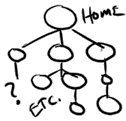

Day-to-day professional and social life rarely demands that we create detailed hierarchies of what we know and how those bits relate to each other, but without a solid and logical organizational backbone your Web site will not function well even if your basic content is accurate and well-written. The four basic steps in organizing your information are to divide it into logical units, establish a hierarchy of importance and generality, use the hierarchy to structure relationships among chunks, then analyze the functional and aesthetic success of your system.
Chunking information
Most information on the World Wide Web consists of short reference documents that are read non-sequentially. This is particularly true of educational, corporate, government, and organizational web sites used to distribute information that might have been printed on paper a few years ago. Writers of technical documents discovered long before the Web was invented that users appreciate short "chunks" of information that can be scanned and located quickly. Short, uniformly-organized chunks of information particularly lend them to Web presentation, because:
Few Web users spend time reading long passages of text on-screen. Most users will save long documents to disk, or print them, rather than read extensive material online. | ||
| Discrete chunks of information lend themselves to Web links. The user of a link usually expects to find a specific unit of related information, not a whole book's worth of information to filter through. But don't subdivide your information too much, or you will frustrate your readers. One to three (printed) pages of information seems about right for a discrete chunk of information on the Web. A link that produces only a small paragraph of information would be silly in most situations. | ||
| A uniform format for organizing and presenting your information allows users to apply their past experience with your site to future searches and explorations, and allows users to predict how an unfamiliar section of your Web site will be organized. | ||
| Concise chunks of information are better suited to the computer screen, which provides a only limited view of long documents. Very long Web pages tend to be disorienting, because they require the user to scroll long distances, and to remember the organization of things that have scrolled off-screen. |
The concept of a chunk of information must be flexible, and consistent with common sense, logical organization, and the convenience of the Web site user. Let the nature of the content suggest the best ways to subdivide and organize your information. There will be times when it makes sense to provide long documents in single Web pages, as integrated units of information. Although chunks of information in online documents should usually be kept short, it makes little sense to arbitrarily divide up a long document. This is particularly true when you want users to be able to print or save the document in one step.
Hierarchy
Any organization needs a hierarchy of importance, if only to determine basic navigation structures for the user. Most "chunks" of information can and should ranked in importance, and organized by the degree of interrelationship among units. Once you have determined a logical set of priorities, you can build a hierarchy from the most important or most general concepts, down to the most specific or optional topics. Hierarchical organizations are virtually a necessity on the Web, because most home page-and-link schemes depend on hierarchies, moving from the most general overview of your site (your home page), down through submenus and content pages that become increasingly more specific.
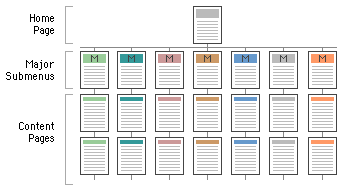
Relationships
When confronted with a new and complex information system users begin to build mental models, and then use these models to assess relationships among topics, and to make guesses about where to find things they haven't seen before. The success of your Web site as an organization of information will largely be determined by how well your actual organization system matches your user's expectations. A logical site organization allows users to make successful predictions about where to find things. Consistent methods of grouping, ordering, labeling, and graphically arranging information allow users to extend their knowledge from pages they have visited to pages they are unfamiliar with. If you mislead users with a structure that is not logical (or have no comprehensible structure at all), users will be constantly frustrated by the difficulties of find their way around. You don't want your user's mental model of your site to look like this:
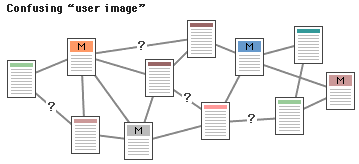
Function
After you have created your site, you should analyze its aesthetics, and the practicality and efficiency of your organizational scheme. No matter what organizational structure you choose for your Web site, proper World Web site design is largely a matter of balancing the structure and relationship of menu or "home" pages and individual content pages or other linked graphics and documents. The goal is to build a hierarchy of menus and pages that feels natural to the user, and doesn't interfere with their use of the Web site or mislead them.

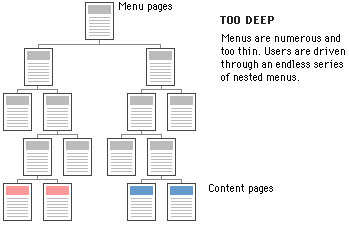
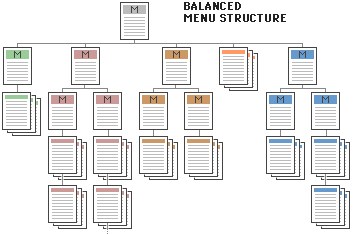
December, J., and N. Randall. 1995. The World Wide Web unleashed. Indianapolis: Sams Publishing. Horton, W. K. 1994. Designing and writing online documentation, 2nd edition. New York: Wiley. |